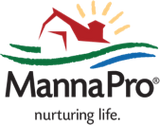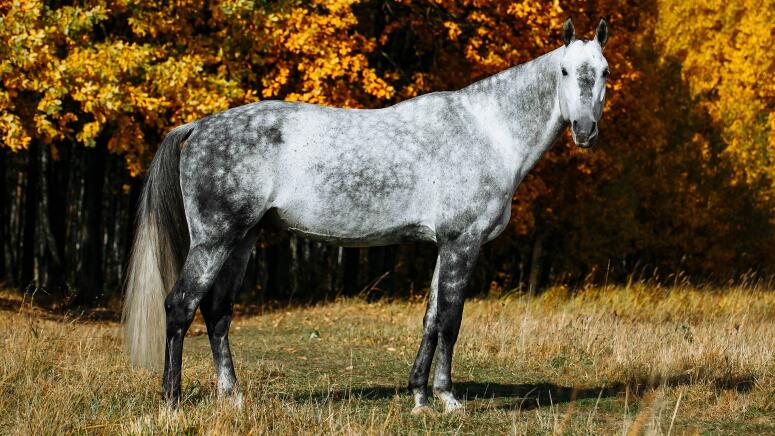
Looking for the best strategy to put weight on a thin horse? Perhaps your horse has gradually lost weight over several months or maybe you’ve just acquired an underweight horse from a neglect case.
Helping your thin horse gain weight can be as simple as slowly increasing your horse’s forage intake or require a multi-pronged solution that includes treating your horse for illness, reducing a parasite burden, adding horse weight gain supplements like rice bran, and/or changing the horse’s environment.
While it may be tempting to “ask the internet” on equine related social media platforms, a wise approach in initiating a nutrition and health care plan for your thin horse, includes consulting with an equine veterinarian and equine nutritionist.
How to Determine if Your Horse is Underweight
One of the most common equine body condition assessment methods in determining if your horse is underweight is to use the Henneke scale to evaluate its body condition score.
Body Condition Scoring (BSC) and the Henneke Scale
The Henneke scale is an equine body conditioning scoring system. Don Henneke, PhD, created the scale in 1979 as part of his equine research at Texas A&M University.
The scale rates the horse, 1 through 9, depending on the quantity of body fat present in six locations: neck, ribs, loin, withers, tail head, and behind the shoulder.
For example, 1 = poor and 9 = extremely fat. A score of 5 is optimal for most disciplines and breeds, though the normal range can vary from 4 to 6.
Though a body score of 4 is in the normal range for a mature horse, it’s paramount to consider a horse’s activity level, age, and reproductive status when determining optimal body condition score.
For example, in a young growing horse, field and clinical findings suggest surplus weight can lead to bone abnormalities, particularly if genetics predispose the horse to developmental orthopedic disease. Maintaining a body condition score of 5 will help safeguard a young healthy horse from unneeded fat that can be detrimental to developing bone tissue.
It’s recommended broodmares maintain a body condition score between 6 and 7.5 transitioning to breeding season and during their entire pregnancy.
Horses are considered to be thin and underweight at a score of 3 or lower. In cases of severe neglect and/or poor health, it’s recommended to work with an equine nutritionist and/or equine veterinarian to develop a balanced and safe feeding plan.
To keep tabs on your horse’s weight changes, take time to periodically run your hand across his side to feel the “cover” over the ribs. This is especially important to do with horses that have thick hair coats as the longer hair can give the illusion the horse is an adequate weight.
"Why Has My Horse Lost Weight?"
Determining the “why” behind your horse’s weight loss is key in making optimal health and nutrition decisions to get your horse back to a normal weight. Horses can lose weight for reasons that encompass both mental and physical components.
There are many factors that can contribute to a horse’s weight loss with each situation being unique to the horse’s age, health status, and environment.
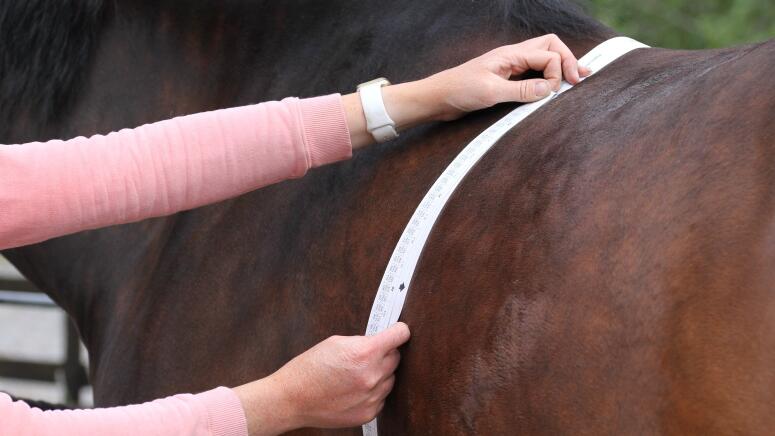
Contributing Factors to Horse Weight Loss
Health Conditions
Stomach Ulcers
Research shows ulcers can be found in 60 to 90 percent of adult horses and 25 to 50 percent of foals, with respect to performance, age, and populations evaluated.
Clinical signs of equine ulcers include but are not limited to: poor appetite, weight loss, and failure to consume a meal. Feed deprivation has also been documented to cause ulcers.
Given the equine research ulcer statistics and equine ulcer clinical signs, one of the cornerstones in getting your thin horse back to a healthy weight may include determining if the horse has ulcers, and if so, implementing an ulcer treatment and management plan.
The plan may include consulting with your equine veterinarian about starting your horse on a prescription medication to help heal your horse’s ulcers and also adding nutritional supplements to support your horse’s gastrointestinal function.
Your equine veterinarian may recommend a gastroscopic exam to definitively diagnose that your horse has ulcers in order to proceed with the most appropriate treatment.
Stomach ulcers may also be diagnosed presumptively, where your veterinarian may decide to skip the gastroscopic exam, and start your horse on ulcer treatment medication and observe the horse’s treatment response.
Digestive Tract Challenges
As a horse ages, his digestive tract may not function as effectively absorbing nutrients. An equine veterinarian and/or equine nutritionist may recommend switching your horse to a more easily digested complete senior feed and/or adding nutritional supplements to improve feed utilization.
Diseases: Metabolic, Infections, etc.
There are a myriad of diseases that can be a component in equine weight loss. For example, a horse in the early stages of pituitary pars intermedia dysfunction (PPID) will experience significantly elevated adrenocorticotropic hormone (ACTH) levels. If the PPID is left untreated it can cause topline and weight loss. Horses with untreated PPID are also at heightened risk of contracting laminitis and insulin resistance.
In addition, infectious diseases like strangles, pneumonia, etc. can cause a horse to go off feed and lose weight.
Arthritis or Chronic Pain
The stress of arthritis pain can depress a horse’s appetite and consequently cause weight loss. The pain may make it difficult for the horse to cover enough terrain in a pasture to intake adequate forage to maintain his weight.
Strategies your veterinarian may recommend to mitigate arthritis pain include nutritional supplements, joint injections, chiropractic adjustments, acupuncture treatments, liniments, shockwave treatments, and/or prescription pain medication.
In the case of chronic foot pain, as with navicular syndrome, your veterinarian and/or farrier may recommend foot trimming or shoeing strategies that can help relieve and manage the pain.
Dental Challenges
If a horse is having problems with his teeth or gums, it can cause decreased feed intake resulting in significant weight loss. Teeth that are fractured, infected, or broken can become so painful that it can keep a horse from properly chewing his feed.
Some signs a horse may have dental problems include “quidding” - dropping wads of partially chewed feed, foul mouth odor, and being uncomfortable or “fussy” with the bit when being ridden.
It’s recommended that horses have yearly dental checkups or every 6 months in the case of horses with prior dental problems and senior horses. Regular dental exams can help identify any developing challenges before they cause a horse to lose weight or encounter other related health problems.
It’s important to note as a horse reaches an advanced age, his teeth may wear down to the point where he can’t adequately chew hay or coarse feed. At that time, he’ll need to switch to a more easily digestible feed like senior feed, soaked hay cubes or pellets, and/or soaked beet pulp in order to maintain a healthy weight.
Parasites
Parasite management in horses is another key component in helping your underweight horse return to a healthy weight.
Internal parasites can wreak havoc on your horse’s health and also contribute significantly to your horse’s weight loss. It’s important to work with your equine veterinarian in developing a parasite management plan.
Internal parasites can cause decreased infection resistance, permanent damage to internal organs, and rob essential nutrients from your horse’s feed.
Side note: When a horse that’s heavily infested with parasites is treated with a paste dewormer, it may trigger colic symptoms. The colic is caused by the impaction of dead worms passing through the horse’s gastric system.
It’s extremely critical to monitor your horse post deworming and contact your veterinarian immediately if colic symptoms arise.
Metabolism
As with people, some horses may have a faster metabolism and require more feed in their diet to maintain a healthy weight. In other words, they are not the proverbial equine “easy keepers” that require seemingly small amounts of forage to maintain a healthy weight.
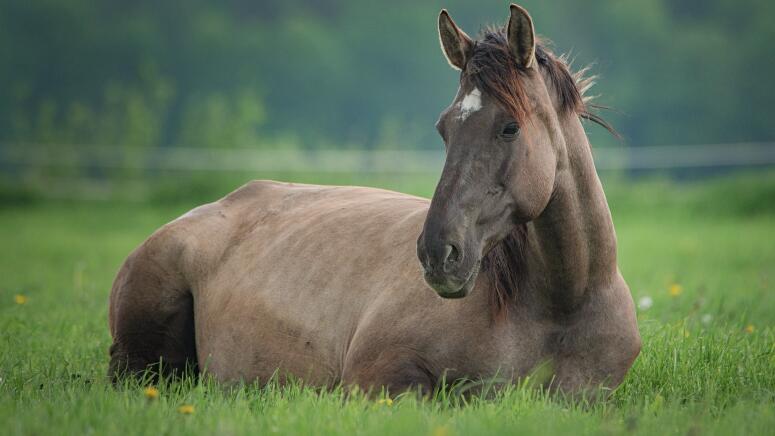
Environment
Herd Dynamics - Herd Order
A horse low in the social order may be deprived of optimal access to water, hay, and other feed. Consider separating the horse during feeding time, turning the horse out with a compatible pasture mate, or separating the horse in an adjacent pasture or paddock.
Insects
During the height of bug and insect season, horses’ grazing and eating may be significantly decreased due to nature’s little annoyances. Protective fly sheets, fly masks, and fly boots in addition to fly sprays and fly repellent ointments can help your horse eat in peace.
When your horse is stabled, stall fans and a barn insect control systems can help minimize insect-related irritations.
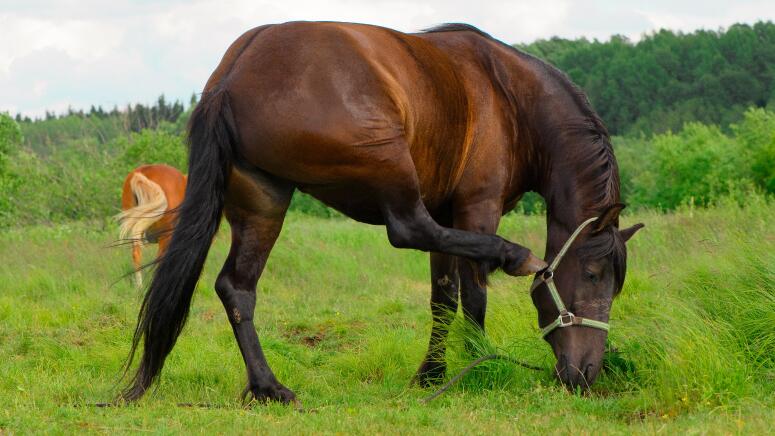
Climate
Climate often plays a role in a horse being able to maintain and/or gain weight.
Thermoneutral Zone
Lower critical temperature & upper critical temperature
Horses are biologically equipped to adapt to varied climates and temperatures. Like other warm-blooded animals, equines need to keep a consistent core body temperature to survive.
For a horse, the thermoneutral zone (TNZ) is the temperature range within which its body temperature is maintained with minimal or zero energy expended. The average TNZ for a mature horse can range from 40°F to 80°F.
The lower critical temperature (LCT) is the lowest temperature within the TNZ and the temperature mark under which a horse has to raise metabolic heat to sustain normal body temperature. Conversely, at temperatures above the upper critical temperature (UCT), a horse needs to decrease body temperature, customarily by panting, dilating the skin’s blood vessels, and/or sweating.
Adult horse LCT can vary greatly depending on the climate - think winter in Florida versus Minnesota. For example, horses in extreme cold environments have a LCT of 5°F while those in mild climates have a LCT of 40°F.
For the majority of horses with a healthy body condition, the critical temperature is around 18°F with a winter coat and 40°F with a summer coat.
Pregnant, young, or growing horses have a LCT of 40°F. Providing the horse remains dry, it can live outside in very cold temperatures with no detrimental health challenges. When the temperatures dip below a LCT of around 18°F, however, horses have to generate additional internal heat to stay warm. The added heat is created by the horse consuming more dietary calories.
A horse’s energy needs will increase 1 percent, around 2 pounds of hay, for each 1° F drop below the LCT. In periods of extreme cold, some horses may need up to 50% more calories. Forages produce more heat because they are higher in fiber than grains, therefore forage assists in maintaining weight and body temperature.
Hot Weather
As humidity and air temperature increase, feed intake often decreases. A horse’s digestion produces body heat from pasture and hay fiber intake. Forages create more heat than grains, because forage contains more fiber. Consequently, during hot periods it’s normal for horses to consume less forage.
Feeding hay during the cooler parts of the day may help to increase intake. If your underweight horse doesn’t consume enough forage to maintain weight, it may be necessary to feed concentrated grain products to meet his caloric needs during hot weather.
Cold Weather
During extended periods of cold weather as in winter, horses will need more hay to keep warm. In more severe cold, horses may also need extra grain added to their diet.
Behaviors
Behaviors like cribbing, weaving, stall walking, and fence pacing increase calories burned. Seek solutions to minimize or eliminate the undesired behaviors such as feeding hay via a hay net or slow feeder or increasing the horse’s turnout time.
Inadequate Water Intake
If a horse is not drinking enough water, feed intake may decrease. Encourage the horse to drink by providing clean fresh water that’s between 45 and 65 F.
Place the horse’s feed and grain near their water source to encourage maximum water consumption. On average, an adult idle horse in a temperate climate will drink around 10 gallons of water per day.
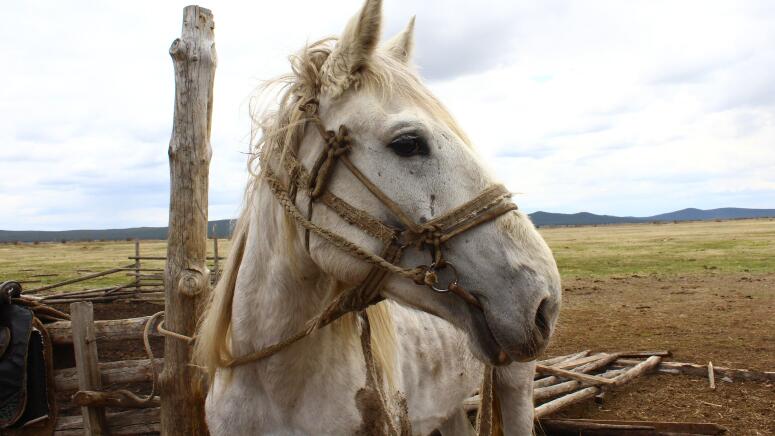
Age-Related
Many older horses have worn or missing teeth which may make chewing forage difficult. In addition, age related digestive tract changes make it more challenging for older horses to absorb and digest nutrients in their hay and grain.
A solution to ensuring older horses get adequate nutrients is to consider feeding a “complete feed”.
Complete Feed Benefits:
- Formulated to be easily digested by horses that can’t chew hay adequately
- Provide 100% of the horse’s daily fiber requirements
Oftentimes older horses require increased time to drink, eat, and may need rest periods between meals. Consequently they may need to be housed separately versus being in the same pasture with more active horses.
The “Special” Horse
While all horses are indeed special, by “special” we mean those horses that march to the beat of their own equine drum. We’ve probably all encountered the Mr. or Ms. “picky palate” that sorts the tastiest grain morsels from the $30 per bag feed and leaves the rest and/or only eats the most expensive premium alfalfa.
In the case of the “special horses” it’s a matter of trial and error to find the preferred hay, grain, and/or supplements that the “special” horse will eat in addition to housing them in an environment that’s conducive to them maximizing their feed consumption.
Weight Gain Feeding Strategy: The Mature Horse
Components of your feeding strategy to help your thin horse gain weight include:
- Forage
- Feed concentrates
- Fats
- Supplements
- Forage first
It’s well known that “forage first” is the kingpin for a horse’s nutrition.
For a horse to maintain a healthy weight, he needs to intake 2 to 3 percent of his body weight daily. At the minimum, 1.5 to 2 percent needs to be good quality forage.
For example, a maintenance amount would be 2 pounds of forage for every 100 pounds of body weight. For a 1,000 pound horse, this would be 20 pounds of forage. More forage may be required if weight gain is desired.
Assess Forage Quality
Just as in human nutrition, food or in the horse’s case, forage quality matters. Poor hay and/or poor pasture can contribute to a horse losing weight. Contact your local county extension agent for assistance in testing your forage for mineral, fiber, and protein analysis.
Investing a few dollars in forage testing can help your horse gain weight more quickly, offer significant long term savings, and greatly improve your horse’s health and well being. For example, if you’re feeding quality hay with adequate protein, you can save money in not having to feed an additional protein supplement.
“Expenses” associated with excessive weight loss can include a negative impact on overall herd health and a decrease in a horse’s conception rate.
Feeding Commercially Available Bagged Forage
If you’re in an area of the country where it’s difficult to get consistent quality baled forage there are a number of companies that offer bagged forage alternatives that guarantee the forage’s nutritional analysis.
Depending on your locale, bagged forage may be equivalent in cost or in some cases cost less than baled forage due to very little waste when fed. Bagged forage also may be more convenient to feed and store versus baled forage.
Feed Concentrates - Proceed with Caution
Commercially available equine feed concentrates, formulated for balanced overall nutrition can be a good calorie source to help a thin horse gain weight, however they must be fed with the utmost caution.
Feeds with high amounts of sugar and starch can induce immediate health problems if fed in large quantities. For instance, if a horse consumes more starch in one feeding than he can digest and absorb in his small intestine, the undigested amount ferments in the hindgut.
This in turn raises the acid levels and detrimentally unbalances the microbial population resulting in a decreased efficiency in the horse’s gut to digesting fiber. Consequently, the chain reaction can cause severe acute laminitis and/or colic.
Select a Feed Concentrate Specifically For Your Horse's Needs
In choosing a feed concentrate, it’s important to select an option that’s formulated for your horse’s activity level and life stage. Be sure to carefully adhere to the feeding label instructions to slowly add the feed to his daily ration.
It’s recommended to feed concentrate amounts no more than 0.5% of the horse’s body weight in one feeding. For a 1,000 pound horse that equates to 5 pounds. Should your horse need more than that amount to achieve weight gain, split the concentrate feedings into as many small meals as possible throughout the day.
Fats - Calories
Fat calories may need to be added to your horse’s feed ration if he’s eating all the forage he’d like yet still not gaining weight after a number of weeks.
Supplementing your horse’s feed ration with fat is one of the safest ways to increase energy in his diet. In comparison, fats provide more than twice the calories of the same amount of grain. Horses can tolerate higher fat intake if it’s gradually introduced to their feed.
A bonus of supplementing with fat versus high grain (high starch) concentrates is that there’s not the erratic variance in insulin and blood glucose levels that result with the grain rations.
There are numerous commercially available fat-fortified feed and grain supplements designed to safely help horses gain weight. The majority are formulated with high fat content in addition to vitamins, amino acids, minerals and other nutrients that support maintaining and building muscle.
Adding Fat - Slow and Steady Wins the Race
Adding vegetable oil purchased from the grocery store is one of the most cost effective and easiest ways to supplement fat in your horse’s feed ration. You can use peanut, canola, corn, or any other vegetable oil your horse prefers.
Granted, the vegetable oils may not have the optimal omega-3 to omega-6 fatty acid ratios, however when your goal is to increase weight on a too-thin horse, the ideal omega ratio is not of critical importance.
As with other feed changes to a horse’s diet, slow and steady wins the race. Oil must be introduced incrementally and slowly, beginning with ¼ cup daily and increasing to an additional ¼ up every few days up to a 2 cup per day maximum for a horse of average size. Ponies and smaller horses will need less.
If you increase the oil too rapidly, your horse may experience steatorrhea - fatty stools and diarrhea. In that case, your horse’s manure will have a glossy sheen due to undigested oils moving through his gastrointestinal system.
Store Oils Properly to Prevent Spoilage
It’s crucial that oils are stored in a cool temperature controlled setting or you risk your oil spoiling turning rancid. Rancid oil is easily identified by its “sour” odor.
Rice Bran
Supplementing with rice bran is another option to increase fat. It’s high in fiber, rich in vitamin E, and most horses really like its taste.
Because rice bran is phosphorus rich, it can inhibit calcium absorption. You may want to consider adding calcium rich alfalfa or adding a calcium supplement if you’re feeding natural rice bran. To ensure your horse gets adequate calcium, consider choosing a rice bran horse formulated product that’s balanced with the optimal phosphorus to calcium ratio.
Similar to adding oil to the horse’s ration, rice bran will need to be titrated slowly beginning with around a cup (about ⅓ pound) daily and ultimately increasing to 1 to 2 pounds daily. For commercially formulated rice bran, follow the label’s feeding instructions.
Digestive Supplements - Probiotics
To promote optimal weight gain, some horses may benefit from probiotic supplements. These digestive supplements are available in powder, paste, and pellet form. The probiotics work to support the horse’s digestive efficiency and nutrient absorption which can assist the horse in achieving and maintaining a healthy weight on less feed.
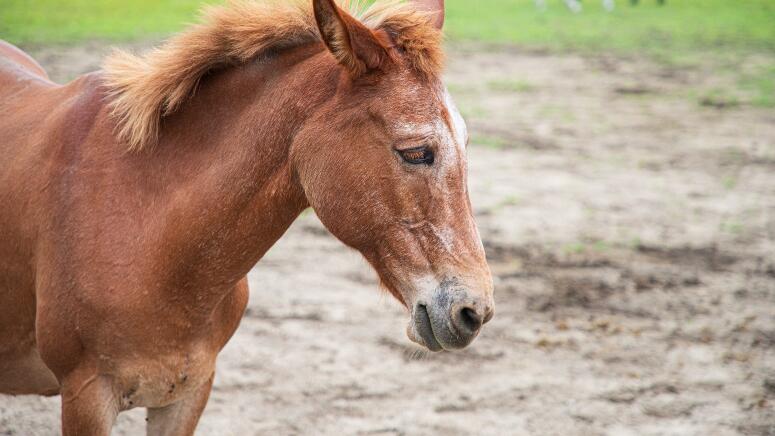
Weight Gain Strategy: the Rescue Horse
When considering putting weight on a very thin rescue horse you may be challenged with multiple factors especially if the horse lands in your care with no medical or behavioral history.
Start with a Veterinary Exam
Because in many cases, the rescue horse’s health history is virtually unknown, it’s important to have a veterinary exam to determine the horse’s health status. An equine veterinary exam can help diagnose concerns that may directly affect the horse’s underweight condition such as ulcers, lameness, shipping fever, strangles, etc.
Treat Immediate Health Challenges
Your equine veterinarian can guide you on the best treatment plan for your unique rescue horse. For example, if ulcers are diagnosed your veterinarian may suggest Ulcergard or Gastrogard to heal existing ulcers and a joint supplement and/or joint injections to provide comfort for lameness. When your horse’s ulcers begin to heal and the joint pain dissipates chances are you’ll see an increase in appetite and weight gain to follow.
Rescue Horse Nutrition and Weight Challenges - Proceed with Caution
The nutrition and weight gain plan for a rescue horse can truly be a matter of life and death. Stacie G. Boswell, DVM, DACVS-LA, equine veterinarian warns, “Feeding grain or weight-building supplements too early can have serious consequences, including death because organs weakened by starvation cannot handle the stress of processing and digesting nutrients.”
She recommends that when a horse has a body condition score (BCS) of 3 or less, a veterinarian be involved to create a refeeding plan as horses can be susceptible to heart, respiratory, and kidney failure if fed too many concentrated calories too fast.
Dr. Boswell observes that In addition to a rescue horse’s physical challenges, the horse can exhibit significant mental stress from not having adequate food. Consequently it may behave abnormally during feeding time. In cases of extreme starvation, a horse’s digestive system may not function properly even after the horse resumes a healthy weight. That may mean it will always be difficult for the horse to gain weight despite years of adequate feeding.
Another tip in helping extremely thin rescue horses gain and maintain weight is to keep them warm during cold weather. A significantly underweight horse will have a difficult time keeping warm because it won’t have enough natural insulation. This applies to horses with lower BCSs even if they are blessed with thick winter hair coats.
Dr. Boswell notes that generally, a horse with a BCS of 3 will require a blanket when temperatures drop below freezing. A horse with a 1 or 2 BCS will need a blanket when it’s less than 40 degrees Fahrenheit. She also advocates allowing recovering rescue horses to be out in fresh air even if it’s very cold versus keeping them in a poorly ventilated closed barn which can lead to respiratory problems.
Feeding a Horse for Weight Gain - Frequently Asked Questions
We caught up with Rob McCoy, Ph.D., Manna Pro Animal Nutritionist and Vice President, Nutrition and Quality Assurance, to get his advice on some frequently asked questions about feeding horses for weight gain:
Q: What are some common mistakes people make when feeding a horse for weight gain?
A: One of the biggest mistakes people make is wanting rapid weight gain and tend to feed too much too quickly. Horses don’t get thin overnight so expecting overnight results is not healthy and can be very detrimental to the horse. A gradual approach is key to proper weight gain.
Another common mistake is people don’t select the best management approach combined with the right products to achieve the intended goal. For example, you can feed less liquid fat than rice bran, but each owner has their preference and the horse may prefer one program over another.
Q: Do you recommend straight alfalfa to put weight on a horse or a combination of alfalfa and another type for forage?
A: I recommend nutritionally balanced high quality forage, and depending on the horse’s need a blend could work best.
Q: Do you recommend having a free choice mineral block available even if the horse is getting mineral supplements in his daily concentrate rations? Why or why not?
A: Depending how your horse is fed, a block is helpful when plenty of water is available, but blocks do not support weight gain. To ensure proper vitamin and mineral intake it’s best to select an appropriate fortified grain mix or supplement.
Q: How do I know if I am doing too much vitamin and mineral supplementation in feeding an underweight horse? How do I avoid over supplementation and posing a danger to the horse by overfeeding vitamins and minerals?
A: Following feeding directions is important. If you’re feeding multiple supplements check with the suppliers to ensure they work well together without too much overlap.
Some feeds are formulated to be complete in nutrients so be cognizant if additional vitamins and minerals are needed based on quantity fed. If you’re not feeding the fully recommended portion/day then additional vitamins and minerals may be needed. If the horse’s base diet is an All Stock feed, then additional supplementation may be needed.
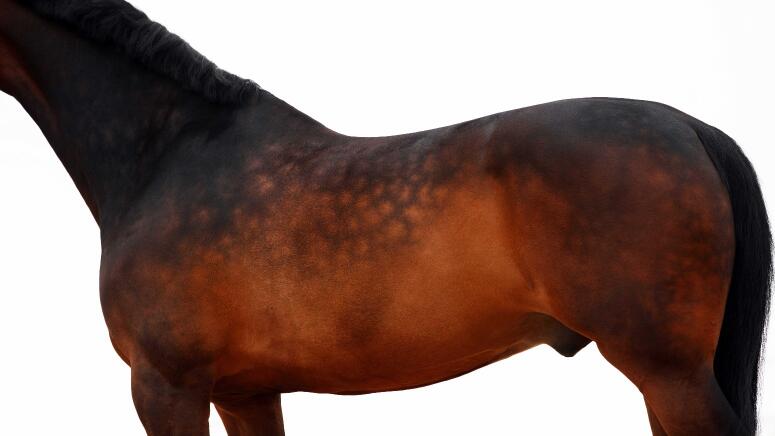
How to Get a Horse's Coat to Dapple
As your once-thin-horse approaches his ideal weight, you may begin to see shiny dapples emerge on his hair coat. On the other hand, you may be wondering why, despite excellent nutrition and grooming, your horse isn’t sporting gleaming dapples. Surprisingly, the answer may simply be your horse wasn’t genetically blessed.
Horse dapples result from a combination of genetics, proper nutrition, and hair coat management. Red and black pigment pattern variations on the hair shaft create the beautiful dapple coat pattern. The hair shaft black pigment deposition results from genes that respond to nutrition changes.
To promote dapple appearance and enhancement, it’s critical that the horse receives optimal nutrition and proper hair coat grooming. As with all horse nutrition programs, start with feeding adequate amounts of the highest quality forage. Be sure to evaluate your horse for stomach ulcers as their presence can directly affect hair coat condition.
Ensure your horse’s nutrition program contains enough protein, specifically the amino acids methionine and lysine. Adding fatty acids can also promote a shiny haircoat, so you may want to add a small portion of a high-fat meal like flax or a plant-based oil like rice bran.
It’s also critical to feed adequate amounts of trace minerals. For example, forage based diets can be deficient in copper and zinc. Zinc and copper are essential nutrients needed for melanin production that affects coat color.
If you’re not sure if your horse’s nutrition plan is meeting his trace mineral requirements, reach out to an equine nutritionist or your veterinarian for guidance. Many equine feed companies also offer complimentary nutrition consultations.
In addition to a properly balanced diet, regular grooming is essential to enhance hair coat quality. Proper grooming practices produce a naturally shiny hair coat bringing a glamorous luster to your horse’s dapples.
Even if your horse isn’t genetically blessed with the hair shaft color variations needed for dappling, you can achieve a beautiful shiny glowing haircoat on your horse with a good nutrition program and regular grooming!
Summary
With a thoughtful approach in evaluating the “why” of your horse’s weight loss, enhancing your horse’s environment, providing essential veterinary care, and a forage-first balanced nutrition feeding program you’ll be well on your way to getting your horse back to a healthy weight.
Manna Pro ~ Nurturing Life
Since 1985, with roots dating back to 1842, Manna Pro has been committed to offering high quality, nutritionally optimized feeds, supplements, and treats for the health and well-being of your horses.
Below are Manna Pro products that can provide safe balanced nutritional support to help your horse return to a healthy weight.
Manna Pro Products to Support Horse Weight Gain
- Feed concentrates
- Renew Gold
- Renew Gold Senior
- Safe Performance Senior Low-Starch Horse Feed
- Manna Senior High Fat Horse Feed
- Max-E Glo Rice Bran Meal and Pellets
- Safe Performance Elite High Fat Horse Feed
Horse Weight Gain Supplements
- Senior Weight Accelerator
- Equine Fat Supplement
- Cool Calories 100
- Natural-Glo Rice Bran
- Calf Manna
- Natural-Glo All Natural Rice Bran Oil
- Cool Omega 40
Gastric Support Supplements
- U-gard
- Jump Start Plus Oral Microbial Gel
- Opti-Zyme Probiotics
Resources
Equine Body Condition Poster free download
National Research Council (NRC) ~ Nutrient Requirements for Horses
- On the NRC website you can enter your horse’s weight, age, workload and status under the “Animal Specifications” tab to easily determine its precise nutritional requirements for macronutrients and mineral/vitamin needs under the “Other Nutrients” tab.
- Under the “Dietary Supply” tab, you can calculate how much of your horse’s nutritional requirements are being satisfied by a specific forage or forage/feed combination.
Nutritional Requirements of Horses and Other Equids by Sarah L. Ralston , VMD, PhD, DACVN, Department of Animal Sciences, School of Environmental and Biological Sciences, Rutgers University
Feeding Young Horses: Graduating to a Grown-Up Diet by Nancy S. Loving, thehorse.com, Oct. 15th, 2018
Horse Nutrition Books:
- Introduction to Horse Nutrition
- Equine Nutrition and Feeding
- The Horse Nutrition Handbook
- The Ultimate Guide to Horse Feed, Supplements, and Nutrition
- Feed Your Horse Like a Horse: Optimize Your Horse's Nutrition for a Lifetime of Vibrant Health
Author Profile: Gabby Bick
Gabby Bick graduated from Truman State University in 2013 with a BS in Animal Science & Nutrition and a minor in Equine Science. Gabby currently works on Manna Pro’s marketing team, and enjoys competing regularly with her six horses.
More Blogs by Gabby Bick
- https://www.mannapro.com/equine/itching-for-spring-learn-to-identify-treat-horse-skin-conditions
- https://www.mannapro.com/equine/best-tactics-for-tackling-mold-on-leather-tack
- https://www.mannapro.com/equine/good-bye-sun-bleaching-6-summer-horse-grooming-tips
- https://www.mannapro.com/equine/horse-skin-conditions-battling-tail-rubbing
- https://www.mannapro.com/equine/got-ticks-how-to-prevent-lyme-disease-in-horses
- https://www.mannapro.com/equine/10-things-you-can-do-with-your-horse-besides-horse-riding
- https://www.mannapro.com/equine/no-hoof-no-horse-8-spring-horse-hoof-care-tips
- https://www.mannapro.com/equine/10-stress-free-horse-transportation-tips
- https://www.mannapro.com/equine/spring-horse-training-tips-conditioning-senior-horses
- https://www.mannapro.com/equine/15-must-know-horse-grooming-tips-secrets
- https://www.mannapro.com/equine/keep-your-tack-room-organized-horse-leather-care-tips
- https://www.mannapro.com/equine/top-5-most-deadly-horse-diseases
- https://www.mannapro.com/equine/beat-the-heat-importance-of-horse-liniments-post-workout-leg-care
- https://www.mannapro.com/equine/see-real-results-with-calf-manna-for-horses-grune-hiedi
Feature Products
